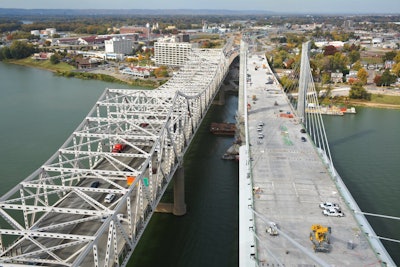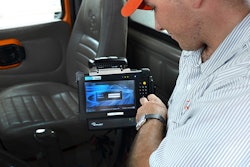
The Midwest region was one of the hardest hit in the economy’s downturn, and it’s also been one of the slowest to recover. The same challenges that plague the logistics industry nationwide – container shortages, lack of rail capacity and truck driver shortages – continue to hurt the Midwest too. But while the coasts, big cities and population centers have seen recovery over the years, the rural areas of the Midwest region haven’t been as lucky.
But the landscape is about to change.
There’s little doubt the Midwest region will become a major battleground in upcoming years as U.S. ports and logistics providers along all three coasts compete for customers transporting goods to these inland destinations.
Anticipating these opportunities, many areas of the Midwest region have prepared for the potential increase in container traffic, from all directions, with infrastructure upgrades to highways, inland ports and railroads throughout the region. But challenges remain.
Upper Midwest struggles with capacity
It’s no secret that the Midwest is the agricultural heartland of the country, so with record harvests these past few growing seasons, many would expect the ag industry to be leading the region’s route back to prosperity. But to hear Richard Murphy, president and CEO of Minneapolis-based Murphy Warehouse tell it, the recent logistical challenges of rail capacity and export container shortages between the coastal ports and the Midwest region continue to hold the upper Midwest back.
“Oil traffic coming from the Dakotas has been playing havoc with rail in the Midwest, especially with the Burlington Northern lines totally jammed with oil trains,” says Murphy. “We may see some relief on the rails from that soon, given the low price for crude right now. But Midwest farmers in recent years have literally struggled to find containers or something to store and move their crops to export because of the container imbalance due to all of the trans-loading being done at the ports now.”
At one time the upper Midwest with its available spaces, cheap prices and good labor pools was an attractive incentive to build new warehouse and logistics operations, but with availability rates for land down in the single digits, the market has dried up due to higher interest rates from banks. With less rail and ocean container capacity, coupled with a lack of available land for development, you’d expect the trucking industry to reap the rewards of all of these logistical challenges in these rural spaces.
“In the Midwest before the recession hit, there were some manufacturers in some of the rural areas that still couldn’t get trucks to go to those outlying plants,” adds Murphy. “Right now the economy is good and most companies can get reasonable truck access, but I can see a time when it happens again because you still have a shortage of people driving the trucks.”
Indiana improves connections to the Southeast
CSX has also been busy upgrading and improving rail connections in southern Indiana, announcing plans back in June to collaborate with Jeffersonville, Ind.-based Anacostia Rail Holdings to spend $90 million on upgrades to the 106-mile rail corridor between Indianapolis and Louisville, Ky., for the Louisville & Indiana Railroad (L&I). When the joint project was announced in June of 2015, CSX president and COO Oscar Munoz called it “a critical infrastructure improvement that includes the installation of new rail, upgrades to the rail bed structure and bridge improvements to enhance safety and more efficient rail service to customers in the Midwest.”
Louisville is also in the midst of major improvements to its highway system, using a $162 million dollar loan from the U.S. Department of Transportation’s TIFIA fund to finance the East End Crossing and Louisville-Southern Indiana Ohio River Bridges Project. The project is designed to provide two new bridges across the Ohio River connecting Louisville to Indiana along I-65. One of the new bridges in downtown Louisville, the Abraham Lincoln Memorial Bridge, opened up for traffic just before Christmas allowing for traffic to use the new route while the existing John F. Kennedy Memorial Bridge undergoes it’s $22 million renovation. Once complete, the seven-lane bridge will improve connections from Indianapolis to the Southeast region and ports in Savanah, Norfolk, Virginia, and Florida.
O’Hare gets a multi-billion dollar facelift
In Illinois, the $8.8 billion O’Hare Modernization Program will help logistics providers throughout the Midwest navigate the congested Chicago metro area. Although most of the modernization project involves improvements directly to the airport for everyday commercial airline commuters, like concourse, terminal and parking infrastructure improvements, but transportation and logistics providers in the area will also gain benefits from the improved traffic flow around O’Hare.
The Elgin O’Hare Western Access Project (EOWA) will add 17 miles of new roads and 15 new or improved interchanges designed to better connect Illinois’ northwest suburbs to the eastern edge of O’Hare along I-90, the Tri-state Tollway (I-294) and the Midwest region in general. Once completed, the project is estimated to save drivers $145 million in time and fuel savings by 2040. It will also decrease traffic by 16 percent during rush hour, reduce delays by seven minutes for the 11-mile trip between the west side of O’Hare and U.S. Route 20.
Ohio the gateway from the East
Many areas along the Eastern part of the Midwest region, namely Ohio and Indiana, suffered right along with the decline in industrial manufacturing in the North America. But Ohio took a proactive approach that may have been perceived as risky at the time, but one that positions them to be a prime benefactor when it rebounds.
“Anytime the economy slows down it is a good time to reassess and invest in infrastructure so you can be ready when things get better,” says Joe Chappel, seaport director at Toledo-Lucas County Port Authority. “Like the (Panama) canal, ports on the seaway/Great Lakes need to modernize and reinvest to be relevant and competitive. We have seen the seaway, vessel lines and ports all step up to make significant improvement to make the system more efficient.”
Located within a day’s drive of nearly half the U.S. and Canadian industrial markets, Northwest Ohio is ideally located for businesses to reach customers and suppliers. No other metro area has every form of transportation available to meet the global needs – highway, rail, sea and air freight. Three of the country’s most traveled interstates (I-75, I-80, I-90) cross through Northwest Ohio, and Toledo is also the largest general cargo port on the Great Lakes and one of the top five rail centers in the country in terms of tonnage handled.
Northwest Ohio has also benefitted from the National Gateway initiative to create a more efficient double-stack Class I railroad route between mid-Atlantic ports and the Midwest markets. The cornerstone of that the double-stack corridor is CSX's Northwest Ohio Terminal that opened in 2011 near North Baltimore, Ohio. The new 500-acre intermodal terminal facility in North Baltimore (40 miles south of Toledo) handles more than 30 trains per day and serves as a critical transportation hub that allows shippers to avoid congested areas like Chicago. In 2014, CSX added two new cranes, bringing the total to seven, which now allows them to handle 900,000 containers a year.
FedEx also recently announced plans to build a 60,000-square-foot distribution center near I-75 in Lima, Ohio, with the help of $10 million in bonds from the Allen County Port Authority. Construction is set to begin this spring, with the hopes of having the DC up and functioning by the end of the year.
St. Louis … one-stop spot for freight
In 2013, the East-West Gateway Council of Governments (EWG) in Missouri and southern Illinois published a freight study that anticipated a 60 percent increase in national freight volume through the region by the year 2040. In order to capitalize on the potential increase in freight, the EWG recommended the creation of a Regional Freight District designed to promote the region’s capabilities, which came to fruition when St. Louis-based Bi-State Development named Mary Lamie as executive director of the new freight district back in July.
One of Lamie’s first tasks at executive director was to tout the region’s competitive advantages against “peer cities” like Nashville, Memphis, Indianapolis and Kansas City, advantages like the fact that St. Louis is the farthest point North on the Mississippi River unobstructed by locks or dams for barge transportation. The Bi-State area also includes six Class I railroads, four Interstate highways with national access and five airports for multi-modal transportation.
“What’s really important (in regards) to our ports and multi-modal facilities potential is that we have a lot of available real estate opportunities strategically located within that freight network,” says Lamie. “We have two international airports in our region with available capacity which makes us an ideal location for e-commerce too, because of the available capacity along the network and a significant presence of FedEx and UPS in the region.”
Although the Bi-State region and St. Louis specifically are poised to capitalize on the potential freight increase through the Midwest, Lamie is quick to point out that there is strength in numbers when it comes to getting federal support for infrastructure projects and a seat at the table when national freight transportation leaders get together to discuss improvements to the freight network.
“We are collaborating with Kansas City and regions like Omaha, Neb., because we feel our strength comes when we work collectively together as a region,” adds Lamie. “Another recommendation from the freight study in 2013 was that we needed to start working closer with our peer cities to let others know what our capabilities are in the Bi-State region.”
With regional economic development groups working together to improve the infrastructure and enhance the region’s image as a great place for freight and logistics operations, there’s plenty of optimism for everyone involved in the global food supply chain throughout all of the Midwest states.
For More Information
Anacostia Rail Holdings, anacostia.com
Bi-State Development, bistatedev.org
CSX Transportation, csx.com
East-West Gateway Council of Governments, ewgateway.org
Murphy Warehouse, murphywarehouse.com
Regional Growth Partnership, rgp.org
Toledo-Lucas County Port Authority, toledoportauthority.org
U.S. Department of Transportation, fhwa.dot.gov


















